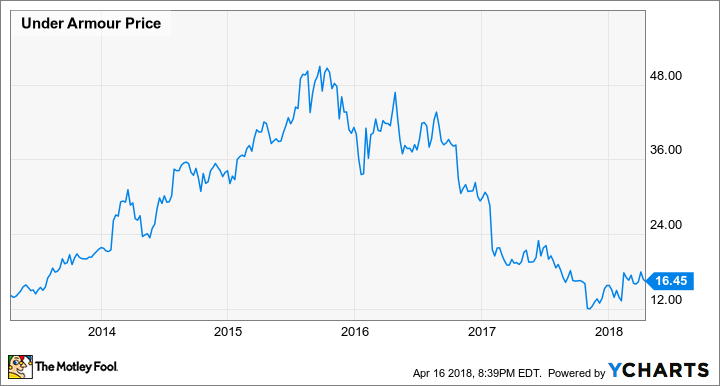In September 2015, Under Armour (UA 1.24%) (UAA 1.21%) could do no wrong. The apparel and footwear manufacturer had just finished its 21st consecutive quarter of 20%-plus revenue growth and released an aggressive strategic plan that promised to more than double the revenue of the company to $7.5 billion by 2018. Investors were impressed and the company's stock hit an all-time high. But since then, things have not gone according to plan and the stock has fallen over 50% from its high. Growth has slowed in many of its key businesses and management's current expectations for 2018 will significantly miss the strategic plan forecasts.
Let's take a look at what went wrong and what the company is focused on now as it works on a new strategic plan.
Lots of whiffs, and one bright spot
The company's game plan in September 2015 projected every segment of its business would continue to grow at a torrid 20%-plus pace, but that didn't happen. The North American market has been significantly challenged for the last two years as key sportswear retailers filed for bankruptcy protection, flooding the market with marked-down sportswear, putting pressure on both Nike and Under Armour to mark down premium-priced products.
Check out the chart below to see how Under Armour looks to do in 2018 compared to projections it gave back in 2015. The chart divides the company's revenue into several, overlapping buckets.

DTC = direct to consumer. Note: All dollar figures in billions.
While Under Armour and Nike have struggled in the North American market, adidas didn't seem to be affected, putting up solid growth results in the U.S. by focusing on athleisure and adapting its products to resonate with the North American consumer. Additionally Skechers and lululemon athletica have launched comebacks and are posting growth domestically.
The success of these competitors indicate that Under Armour's problems are due partly to something company-specific. Apparel and footwear products were originally expected to deliver a combined $6.6 billion toward the $7.5 billion 2018 goal, but are now expected to deliver just $4.4 billion this year. Much of the problem was that in pursuit of growth, the company released too many products, making it confusing for customers. Ultimately, many of these products had to be sold at discounts. Adding to the issue, the company's product development cycle was too long, marking it hard for the company to correct these issues quickly. These problems probably contributed to the company's inability to execute in its key growth categories such as women's apparel and footwear.
Of the six divisions in the September 2015 plan (shown in the above chart), international is the only one on target to meet its original 2018 revenue goal. Under Armour's international segment has grown 69%, 63%, and 46% in the last three years, respectively, reaching $1.1 billion. The company has expanded internationally with a smart combination of branded retail stores, partners, and country-specific e-commerce websites. At only 23% of overall revenue in 2017, this business is certain to be a central part of the company's new strategic plan.

Image source: Getty images.
Now what?
With a difficult 2017 behind it, President and Chief Operating Officer Patrik Frisk has been working on Under Armour's transformation. During the fourth-quarter earnings call with analysts, he talked about the company's current focus: fixing what's broken, selectively fueling the best opportunities, and simplifying its product offerings.
Fixing the company's product delivery engine and its North American business are a priority for Under Armour. Frisk is driving the product creation process to be more customer-focused and making it easier and faster for the company to deliver new products. In North America, Frisk indicated the company needed to continue "to evolve our distribution relative to the quickly changing market," which is likely code for investing in its own direct-to-consumer business.
The second area of focus is investing in the company's best growth businesses, including direct-to-consumer (DTC), international, and select product categories. The company's DTC business (company branded stores and e-commerce websites) are a chance for Under Armour to highlight the company's full product line, more directly control the brand experience, and enable results internationally. Look for the company to continue to accelerate DTC in international markets such as China and EMEA (Europe, the Middle East, and Africa) where the company has a significantly smaller market share than Nike and adidas.
For product categories, Frisk indicated Under Armour is focused on men's training, running, and women's training, which are "the areas with brand strength, the largest market opportunity, and most consistent growth." As the company makes these product categories a priority, something else has to give, and that's where its simplification effort comes in.
Frisk has stated he wants to cut 30% to 40% of its SKUs (stock keeping units) over the next two years. In addition to the improvements in the company's product development process, less SKUs will enable its product development and design teams to be more effective. Frisk believes this "will ultimately drive better product from us in both the short term and the long term."
Even though the $7.5 billion in revenue won't materialize this year -- the company reported $5 billion in 2017 revenue and expects a low single-digit percentage jump this year -- the company has learned valuable lessons on what can go wrong building a strategic blueprint.
I like the company's current focus of shoring up its weaknesses, investing in strengths, and simplifying its product line. As the company executes over the coming months, it should give management more confidence in building its new strategic map to profitable growth.






